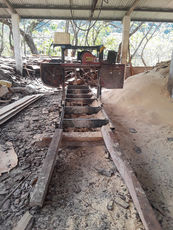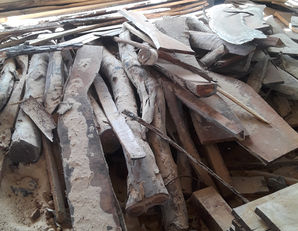LA YEGUADA, PANAMA.
Zero waste // Plant based // Maker-community support




PROJECT INTRO
In the 1960’s, 7090 hectares of degraded land (former cattle ranches) in La Yeguada, Central Panama, was reforested to protect the country’s first public hydroelectric plant. Caribbean pine (Pinus caribaea) was planted as it was the only species that survived and thrived in the degraded soils. Besides protecting soils from eroding into the watershed, the pine plantation offers the surrounding communities livelihoods: 2000 hectares can be rotationally harvested and used by surrounding communities, who currently fabricate shipping pallets.
The Community Association of La Yeguada recently invited Fundacion Comunidad, Modest and students at Parsons School of Design, to come up with creative ideas to utilize the waste, such as sawdust and cut-offs.
(To view students projects, click here!)
Besides utilizing Pinus caribaea as our main material source for new product-ideas, Modest’s aim is to encourage diversity in managed forest systems: forest tree plantations are often monocultures with limited ecological value, and therefore we encourage the cultivation and application of a multitude of plant-based materials (dyes, finishes, fibers etc), that can be grown in tandem with managed forests or in ‘live fences’ typically surrounding agricultural fields.
In addition to creating new economic opportunities for the community, our proposal/s will have multiple ecological benefits: boosting overall ecosystem services that plants provide (soil conservation, carbon sequestration, hosting beneficial insects which can minimize synthetic fertilizers applied to nearby agricultural fields) to providing enriched habitat for Panama’s wildlife.
Over the last decades, large parts of Central America have experienced forest loss due to conversion to agricultural systems (cultivated, cattle ranches) which has negatively impacted ecosystems and their function. Modest's aim
is to find strategies to revegetate areas in a way that also economically benefits surrounding communities - generally through production of designed products, primarily for the domestic market.
This project is done in partnership with Fundacion CoMunidad in Panama, a strategic partner of FAO, and is currently in it's research phase. Implementation: Summer 2021.
Below is a snapshot of our process.
Images from the La Yeguada pine plantation and community wood shop.
Photo credits: C. Facella, P. Cambronero, Fundacion CoMunidad.

1 // SITE ANALYSIS
SYNOPSIS // DESIGN CRITERIA
REFORESTATION, 1960’s LA YEGUADA:
CARIBBEAN PINE,
(A MONOCULTURE PLANTATION)
Diversify vegetation surrounding pine plantation, using live fences to create linear forests.
FRAGMENTED FORESTS
Through live fences / linear forests,
reconnect fragmented forests.
WASTE / MATERIALS, LA YEGUADA
Primary material source: Caribbean pine. Secondary sources: Paper and plastic ‘waste’. Wood finishes and fibers cultivated in live fences / linear forests.
CATTLE RANCHING IS RESPONSIBLE FOR
65%OF DEFORESTATION IN LATIN AMERICA
Diversify income opportunities through wood skills-building workshops for community / wood shop. Enhance camping sites + ecotourism opportunities.
PANAMANIAN IMPORTS AND EXPORTS:
WOOD PRODUCTS
Revive domestic production of wood-based furniture and house-hold goods.
MATERIAL EXPLORATION
Sawdust casting compound

Lime
Shavings
Sawdust
Cement






RECIPE E
-
4 parts wood shavings (small)
-
3 parts fine concrete (rockite)
-
1 part sand
-
1 part lime
-
2 parts water
MATERIAL EXPLORATION
Investigating plant-based dyes and processes // Local plants

ecological value:
Loved by birds who are unaffected the toxins, including gray catbird , northern mockingbird, northern cardinal, brown thrasher , mourning dove, and cedar waxwing.
Small mammals such as raccoons, opossums, red and gray fox, and the white-footed mouse, also enjoy the berries.
The giant Leopard moth (Hypercompe scribonia), feeds on pokeweed. Material uses: Red dye/ink. Historically used to give deep red color to port wine.
pokeweed // Phytolacca americana


edible:
Entire plant including fruits are significantly toxic if ingested by humans and most domestic animals, although spring shoots are edible when young.
Cooked leaves and stems are a traditional Appalachian food (must be cooked three times),
and have tastes similar to spinach and asparagus.
‘Poke sallet’ festivals are held annually in smaller communities, to commemorate the plant as a food and medicinal source.
Gray Catbird. Sibley.
Mockingbird. Sibley.
phytoremediation:
Remediate soils contaminated with cadmium, zinc, lead and manganese.
other:
Use of toxins to potentially control invasive zebra mussels and snails Considered a weed by farmers. Rootstock can be used as a soap substitute.
medicinal value:
Recently been investigated as a remedy for HIV.
TEAM INFO
consultants / lead

Team Lead, Landscape Restoration Architect and Product Designer: Christine Facella

Sustainable Development Partner and Team Co-Lead: Alberto Pascual / Fundacion CoMunidad

Social Designer and Strategist: Andrea Miranda Salas
Bloomist, West Elm, Martha Stewart


Design Consultant:
Johanna Nilsson
Burberry, Louis Vuitton

Design Consultant:
Virginia Cavalletti
Bank of America, Doums Academy

Material and Process Consultant:
Doug Dietrich (carpenter).

Conservation Biologist Consultant:
Dr. Kimberly Terrell
Smithsonian, Tulane Environmental Law Clinic
designers







partnerships
Sources:
1. Nancy L. Matthews, 1987, "Appendix F: Habitat Assessment Manual," in Report: Anne Arundel Co., Offc. Planning and Zoning, Environmental and Special Projects Div., to Office of Coastal Resources Management, NOAA and State of Maryland Chesapeake Bay Critical Area Commission, August 1987
2. Donald W. Hall, 2015, "Giant woolly bear (larva), giant or great leopard moth (adult) [scientific name: Hypercompe scribonia (Stoll 1790) (Lepidoptera: Erebidae: Arctiinae)]," at Institute of Food and Agricultural Sciences: Featured creatures, Gainesville, FL:Florida Department of Agriculture and Consumer Services, Division of Plant Industry
3. Mansouri S, Kutky M, Hudak KA (2012) Pokeweed Antiviral Protein Increases HIV-1 Particle Infectivity by Activating the Cellular Mitogen Activated Protein Kinase Pathway. PLoS ONE 7(5): e36369. https://doi.org/10.1371/journal.pone.0036369
4. Harold H. Lee; Peter C. Fraleigh & Lemma Aklilu, "Method of controlling zebra mussels with extract of Phytolacca dodecandra", published 1993
5. Weiner. M. A. Earth Medicine, Earth Food. Ballantine Books.
6. Xiang YanCi; Feng Tao; Peng XiuHua; Yao GuoQin, Effect of phytoremediation of manganese mine tailings contaminated soils by Phytolacca americana on following plants, Journal of Ecology and Rural Environment 2009 Vol.25 No.3 pp.63-68 ref.22
7. Harris. B. C. Eat the Weeds. Pivot Health (1973-00-00)






























